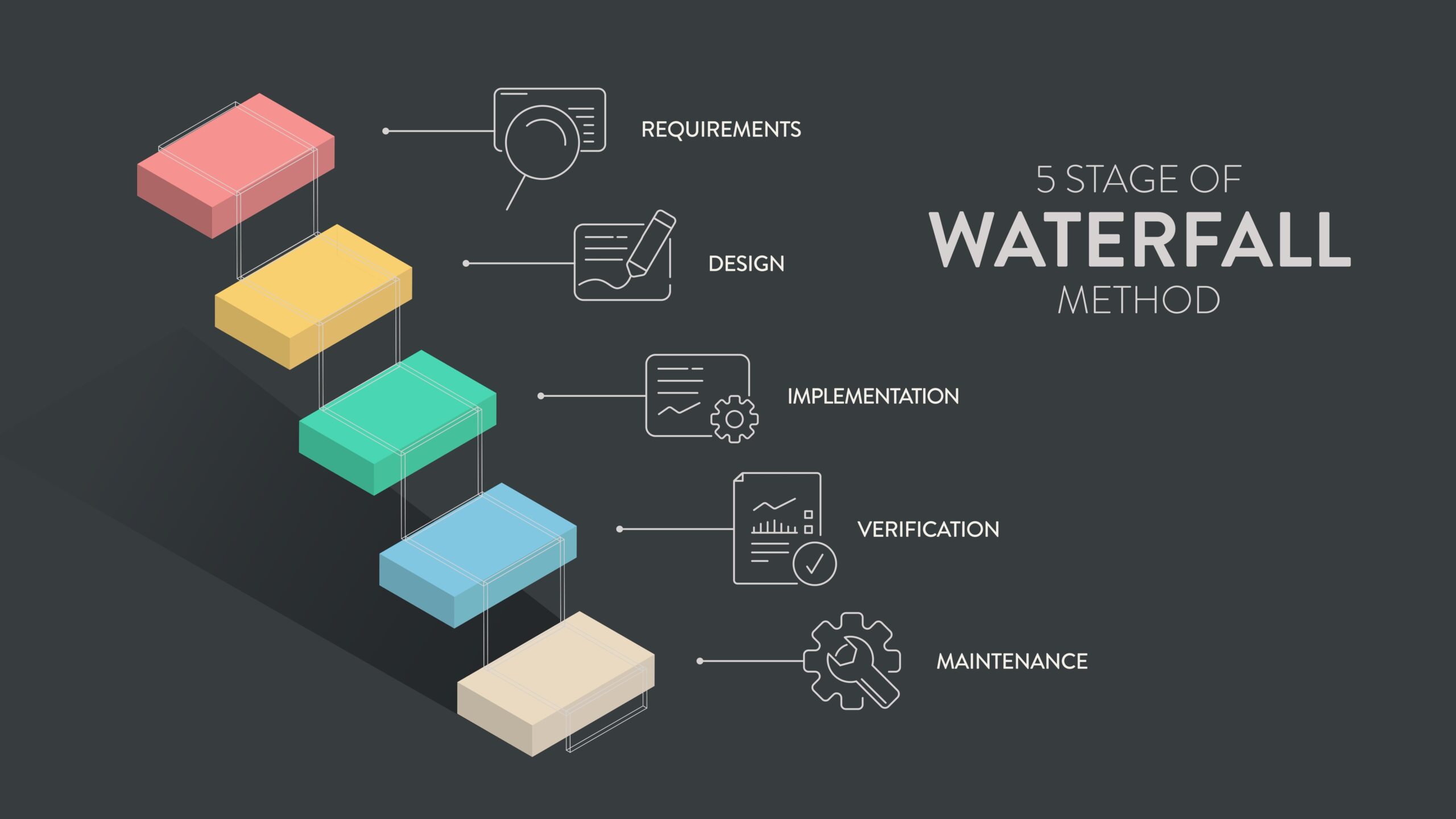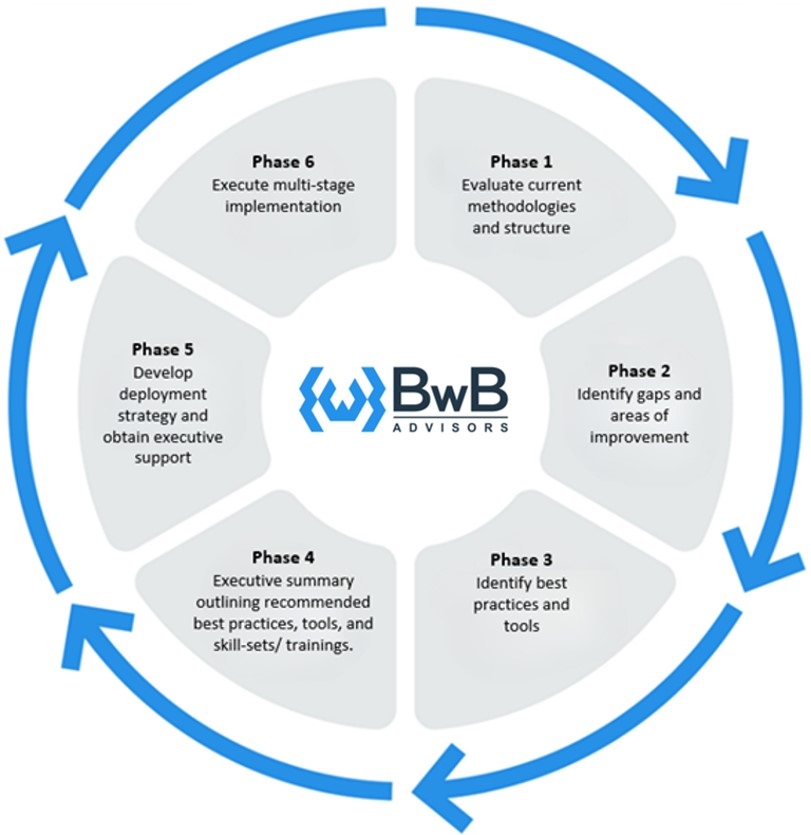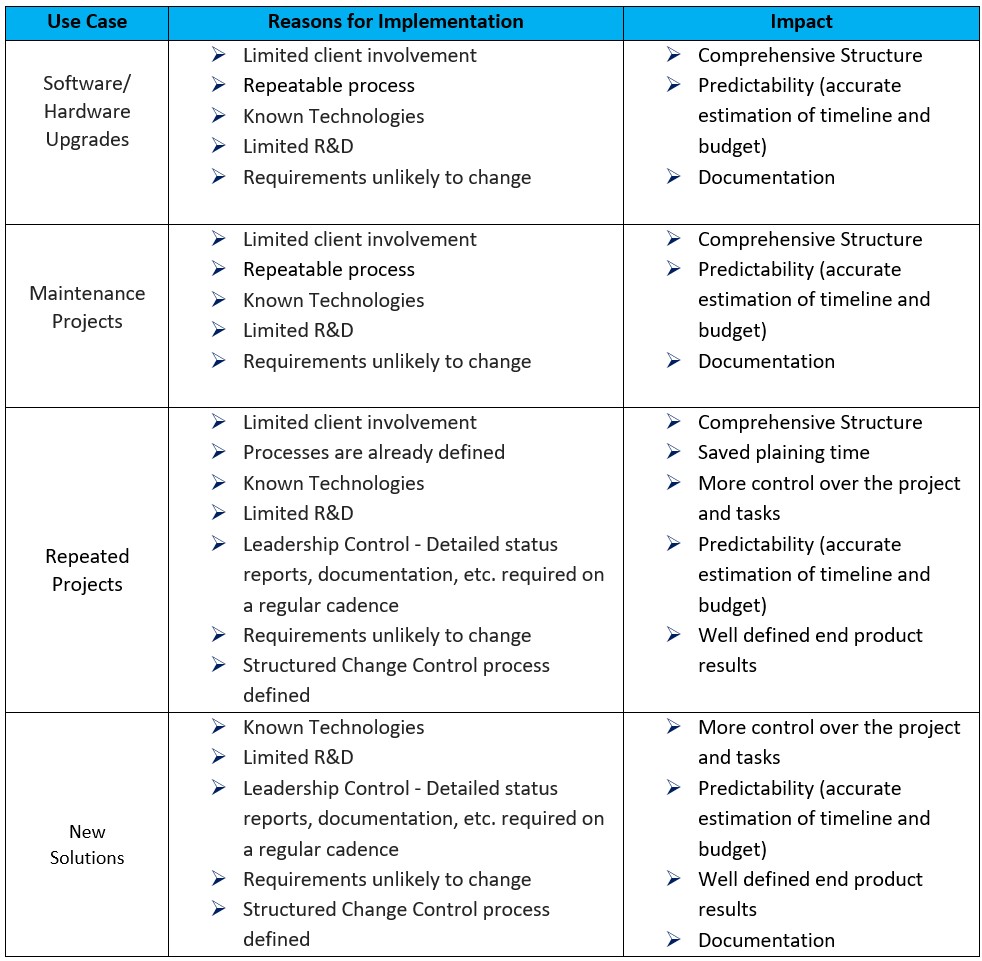Project Management Office - Waterfall
Waterfall is a highly utilized & impactful methodology that provides improved planning, increased efficiency, and superior project quality. In this installment of our Project Management Briefing series, we will focus on the Waterfall methodology, its key benefits, business impacted use cases.
Overview:
The Waterfall methodology is a traditional project management approach that was formalized in 1970 and has been enhanced over the decades to effectively manage various types of projects. Waterfall follows a linear and sequential process, utilizing a set of steps/ stages that follow a pre-specified order. The methodology is front-loaded to rely on careful planning, detailed documentation, and consecutive execution, which makes it ideal for projects where the requirements and end results are clearly established upfront, projects that require a lot of predictability, and projects that are repeatable. Utilizing the Waterfall methodology provides the framework, workflows, and best-practices necessary to ensure projects are completed on time and within budget.
While there has been a lot of buzz in recent years around newer methodologies, the majority of organizations still rely on the tried-and-true framework provided by Waterfall. According to a 2022 study conducted by PMI (Project Management Institute), 56% of all projects still use the Waterfall methodology, as opposed to 22% using Agile, 19% using a Hybrid approach, and 3% using other methods [1]. Additionally, many companies claim they are switching to or are currently utilizing other methodologies such as Agile, but a significant number are still following the principles of Waterfall, such as maintaining status reports, detailing project plans, etc. [2]. While there can be measurable benefits to using other methodologies depending on the use case, the practices derived from Waterfall have become so common and effective that it is the go-to project management methodology across numerous industries.

Waterfall projects are typically broken out into 5 main stages: Requirements, Design, Implementation, Testing/Verification, and Maintenance. In the first stage, the project requirements are gathered and documented, this includes identifying the project goals, objectives, and scope. In the Design stage the team creates a detailed project plan that outlines how the project will be executed; major outputs of this stage include the project schedule, resource requirements, estimated capital, etc. needed to complete the project. Next is the Implementation stage, which is when the project team begins executing the project plan, this includes building the outlined deliverables. In the Testing/Verification stage, the project team does thorough testing of the project deliverables to ensure there are no issues and that they meet all requirements outlined in the design plan. Finally, during the Maintenance stage, the asset is transferred to an operation organization that is responsible for maintenance and support. The sequential nature of Waterfall is further reinforced by requiring that all tasks in the current stage be completed before any tasks in the next stage begin, which helps to reduce risk and ensure the quality of deliverables. While these five stages are the standard division, it is common for the number of stages (and corresponding tasks) to vary as the methodology is tailored to the specific project/use-case.

Key Benefits:
The Waterfall methodology yields a variety of benefits that can vary depending on the solution and supporting best-practices and tools being implemented. Some of the most common benefits of using Waterfall include: Improve Planning & Efficiency, Reduced Risk, Enhanced Quality Control, Accurate Estimation of Cost and Timelines, and Comprehensive Documentation
Improve Planning & Efficiency: The Waterfall methodology is suited to projects with static deliverables that are well-defined from the start. As such, project managers are able to outline clear expectations and deliverables for each stage of the project, making it easier to implement and manage. This also helps to account for items such as budget, resources, and timelines in advance, making the project implementation smoother and more efficient.
Reduced Risk: The Waterfall methodology is good for keeping projects on track and within budget as the requirements are all defined up front and the project plan is built around them. Furthermore, if modifications to the requirements are needed during the project, a strict change management procedure is followed to fully assess the impact on time, cost, and budget.
Enhanced Quality Control: A key part of the Waterfall methodology is the use of stage gates, which are essentially checkpoints at the end of each phase in the project lifecycle. By utilizing these stage gates and not moving forward until that part of the project is completed and validated, the quality of each component as well as the overall product is ensured
Accurate Estimation of Cost and Timelines: The precise planning when following Waterfall allows project managers to effectively and accurately create project plans, schedule tasks, designate resources, and give budget estimations.
Comprehensive Documentation: The Waterfall methodology promotes the creation and utilization of extensive documentation to ensure that everyone is on the same page. The documentation typically includes things like project requirements, deliverables, timelines, and budget. Detailed descriptions of each phase of the project and the corresponding tasks and deliverables are also outlined. This ensures that everyone knows what is expected of them and what needs to be delivered during each stage of the project. Having this level of documentation also helps new team members quickly catch up with the requirements, tasks, and progress, reducing time delays when new resources are needed.
Use Cases:
While a significant number of organizations utilize the Waterfall methodology, there are industries and use case where Waterfall is the most effective. Some of the most common industries that leverage Waterfall are IT, construction, manufacturing, and aerospace as more sequential processes are required in these fields.
See the table below for examples of Waterfall uses cases and impact within the IT industry:
Implementation Best-Practices:
Getting the most out of the Waterfall methodology is highly dependent on implementing it correctly. When implementing the Waterfall methodology there are certain steps and best practices that should be followed to ensure success. As with any project, ensuring a valid business case and stakeholder support is the first step. By clearly outlining the business benefits, end goals, risks, and necessary investment, the team can confirm that the project is worth proceeding with, and obtaining sponsor/ stakeholder support makes sure that everyone fully understands the reasoning for the project and the benefits it will provide. The next step is to verify that the nature of the project suits the Waterfall framework. Waterfall is optimized for projects that have static, well-defined goals and requirements from the beginning, whereas projects that have changing requirements or an undefined final product tend not to work as well with Waterfall.
Another important component is utilizing the correct tools. Common tools used with the Waterfall method include Collaboration, Testing, Code Control, and Planning tools. Collaboration tools such as Microsoft Teams, Google Suite, etc. are essential in enabling team members to work together on documents, plans, and other project work in real time. Testing tools like Selenium and JUnit help ensure that the project deliverables meet all requirements in an efficient way. In IT-related projects, Code Control tools such as GitHub help to effectively manage code version control. Finlay, Planning tools such as Microsoft Project, Gantt charts, etc. help create a project schedule and identify the resources needed to complete the project. By using these tools effectively, teams can work together more seamlessly and provide quality deliverables more efficiently
While there are numerous other Waterfall best-practices tailored to the project type, paying extra attention to these standard best-practices can significantly help to improve the success of implementing Waterfall as well as the project by extension.
Limitations:
Waterfall is a useful methodology, however, projects can still face issues, and there are cases where Waterfall isn’t the best option.
First off, Waterfall's sequential nature makes it challenging and time-consuming to accommodate changes or new requirements once a phase is completed, which limits flexibility and adaptability. This can be problematic in dynamic environments where requirements evolve over time. Secondly, Waterfall can reduce market opportunity as the full product has to be built before it can be deployed, as opposed to Agile where an MVP (minimum viable product) is released much earlier, then built on. Thirdly, the heavy emphasis on upfront planning and documentation can result in longer lead times, and if the documentation is not correctly balanced, its creation can become a waste of time and money. Additionally, there are cases where Waterfall may work, but the project is better suited for other methodologies. For example, projects where the requirements are in flux, where the client wants to be consistently involved, or where there are a lot of unknowns (i.e. things that will require a significant amount of R&D) will all run more efficiently in an Agile or Hybrid setting. We will further discuss the benefits and uses cases of these other methodologies in future installments of out Project Management Briefings series.
Like anything else, the Waterfall methodology has its pros and cons, which is why it is important to verify that Waterfall is the best fit for the project. Furthermore, while using Waterfall provides enhanced planning; changes, issues, or delays almost always occur during some point of any project lifecycle, therefore teams using this methodology (or any other project management methodology) should plan for potential roadblocks to ensure that they can be effectively mitigated.
BwB Advisor’s Methodology for Optimizing Project Management:
While there are a vast number of methodologies, tools, and best practices available to help optimize project management, organizations should proceed cautiously in deciding what to adopt — one size does not fit all.
At the BwB Advisors our Project Management Optimization Methodology (PMOM) follows a 6 phase process that provides a comprehensive roadmap from identifying key best practices, tools, and methodologies. This helps to ensure a successful implementation that leads to improved productivity, reduced costs, and increased project success.

To learn more about our PMOM, click here or reach out to us to see how our PMOM can help you by clicking here.
July 2023 / Insights / By: Michael T. Casarona
References:
[1] monday.com, A. of us at. (2023, March 7). A complete guide to the waterfall methodology in 2023. monday.com Blog. https://monday.com/blog/project-management/waterfall-methodology/#:~:text=Yes%2C%20even%20in%202022%2C%20a%20wide%20range%20of,Waterfall%20%E2%80%94%20methods%20in%20the%20past%2012%20months.
[2] When waterfall principles sneak back into agile workflows. Harvard Business Review. (2021, August 27). https://hbr.org/2019/09/when-waterfall-principles-sneak-back-into-agile-workflows.

